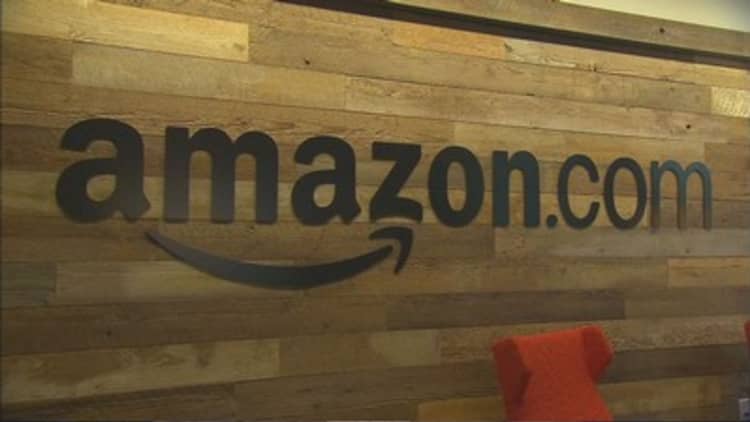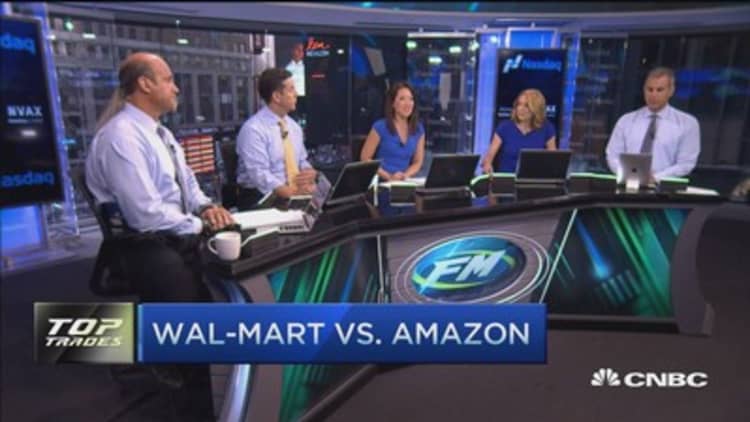
When retailers come out with promotional guns blazing, it's often an indication that they need to rely on gimmicks to lure shoppers away from the competition.
So when news of Amazon's Prime Day—a 20th anniversary event that promises to offer more deals than Black Friday—hit just weeks after Wal-Mart announced a forthcoming subscription service, many assumed Amazon was striking back at the big-box retailer and the encroaching Alibaba, or proactively trying to stem losses to the soon-to-launch Jet.com.
Talks of a battle between Amazon and Wal-Mart intensified on Monday, when Wal-Mart took aim at Amazon's sales event by saying that shoppers "shouldn't have to pay $100 to get great deals." It simultaneously announced that it would launch more than 2,000 rollback deals on Wednesday—Prime Day—and lowered its free shipping threshold to $35 from $50.
Although Amazon is no doubt using the anniversary sale as a tactic to drive loyalty among Prime members and recruit new followers, analysts agreed it is not an indication that the company feels threatened.
Instead, as the country's largest online retailer looks to extend its lead, it's using the event to promote benefits that other retailers don't offer in their subscription services, and expand its presence overseas.
Read More
Meanwhile, analysts are watching to see if Amazon will treat the event as a one-off sales campaign, or fall into the same pattern of aggressive sales events that have plagued its competitors, Forrester Research analyst Sucharita Mulpuru said.
"Because Amazon so rarely does events like this, it is something special," Mulpuru said. "There's a part of me that wonders, is this a slippery slope down for them?"
Winning the ‘arms race’
It's no wonder Amazon wants to keep a close eye on subscribers to its Prime service, which boasts an estimated 44 million members, according to a report released Wednesday by Consumer Intelligence Research Partners. The research firm estimated Prime members spend on average $1,200 a year with the retailer, as opposed to $700 a year for nonmembers.
A study released earlier this year similarly found that Prime members are less likely to abandon Amazon's site in favor of a competitor's. That research, conducted by Millward Brown Digital, found that a non-Prime member is eight times more likely to cross-shop between Amazon and Target in the same session.
"Once they get into the system and they start using it, it changes how [they] behave," said Anne Zybowski, vice president of retail insights at Kantar Retail.
As other retailers have taken aim at Amazon, it's responded by upping the benefits of Prime subscriptions. That includes the recent addition of same-day delivery to more markets, and adding more eligible items. According to Goldman Sachs, these improvements make it difficult for other retailers to enter an online "arms race" with Amazon.
Along those lines, Zybowski said that Prime Day is designed to encourage people to use Prime for more than free shipping. In its marketing campaign, the retailer is promoting its Prime Photo storage and Prime Music streaming services, and will give away thousands in Amazon gift cards to sweepstakes winners who listen to a song on Prime Music, or upload an image to its contest page.

Although these types of benefits pale in comparison to the recruiting power of free shipping, which 71 percent of members who had joined Prime in the past year listed as their primary reason, "It is notable how many shoppers [16 percent] cited other digital content benefits as the primary reason they paid $99 for membership," according to Kantar Retail's December ShopperScape survey.
Read MoreAmazon sees Wal-Mart's bet, raises ante
"[Amazon Prime] is more than just a two-day delivery service," said Tim Barrett, a retail analyst at Euromonitor. "I imagine that a lot of these features aren't even being used by a decent amount of members."
These extras, along with quicker delivery times than Wal-Mart's Shipping Pass, the absence of a minimum order for free deliveries that's required by Jet.com, and having millions more eligible items, give Amazon an edge over the cheaper $50 competing memberships.
They've also contributed to higher renewal rates. In the most recent quarter, 95 percent of members renewed a paid Prime membership after one year, according to CIRP. That's up from 90 percent the previous two quarters.
"Amazon's efforts to make the Amazon Prime membership more valuable and further integrated into customers' lives, with enhanced video and music offerings, as well as additional shipping benefits, appears to have paid off," said Mike Levin, partner and co-founder of CIRP.
What's more, with Prime Day benefits available in the U.K., Spain and other countries abroad, the event will also help Amazon become a more dominant player abroad, Zybowski said.
"They're becoming much more global," she said.
Lead it not into temptation
Though analysts agreed that Amazon's Black Friday in July event will succeed in boosting sales during what's traditionally a slow month for retailers, Mulpuru said its revenues won't be anywhere near as big as the $2 billion in sales from Cyber Monday—the largest online sales day of the year in 2014.
"People aren't expecting to buy on this day the way that they expect to buy on Cyber Monday," Mulpuru said.
It will also fall well short of Chinese retailer Alibaba's Singles Day, an annual promotion celebrating the country's bachelors. In November 2014, its sixth year holding the event, Singles Day sales hit $9 billion.
By comparison, Amazon's net product sales—revenue that it generates from merchandise it sells to shoppers—reached $16 billion in the third quarter last year. Prime Day falls in Amazon's third quarter this year.
Read MoreRetail eyeing a cure for the summertime blues
Despite falling short of these mega sales figures, Amazon's sales event is clever in that in evokes the deep discounts associated with Black Friday sales, without relying too heavily on the "Christmas in July" tactics that other major retailers typically use, Zybowski said.
"It's smart because it's not screaming Christmas … which often times puts people off," she said.
Mulpuru added that what makes this deal so special is that, unlike retailers including Target and Wal-Mart, Amazon rarely holds these types of events. To her point, Target just ended its annual Black Friday in July sale, whereas Wal-Mart said its new round of rollbacks will last the typical 90 days, "Because we’ve always believed in giving customers low prices every day."
Mulpuru's only caution on Amazon's event is that it avoid falling into the same trap as its competitors—becoming too reliant on heavy promotions.
"You see what a lift you can get and then you do the math," she said. "You're almost forced into anniversarying it the following year, otherwise you might not make your numbers."
"It'll be interesting to see if they are one of the merchants that can avoid that fate," she said.


